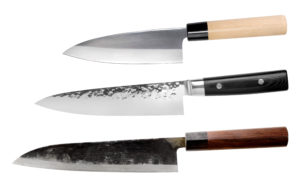 There are a number of laminated Japanese kitchen knives on the market today. Like Japanese chisels, these usually have high-carbon steel laminated to a piece of stainless steel or between two pieces of stainless steel. And like most Japanese tools, Japanese knives require a level of care and respect that most Westerners are unprepared to give such an inanimate device.
There are a number of laminated Japanese kitchen knives on the market today. Like Japanese chisels, these usually have high-carbon steel laminated to a piece of stainless steel or between two pieces of stainless steel. And like most Japanese tools, Japanese knives require a level of care and respect that most Westerners are unprepared to give such an inanimate device.
Japanese knives will take a very fine edge an can cut paper-thin slices of meat or vegetables. One of the difficulties with them is that the high-carbon steel is very brittle and the knives should generally not be used for chopping of any kind. The edges chip too readily.
You should also be very careful when using honing rods of any kind with Japanese kitchen knives. The high-carbon steel is sufficiently brittle that it can be chipped on honing rods. In particular, you do not want to use one of the small devices with crossed honing rods shown in the photo at left above. The crossed rods are fine for Western knives, but if you draw a Japanese knife between sets of rods like these with any amount of pressure on the knife, you will virtually destroy the edge. It will have a series of small chips all the way along it caused by the wave action of the rods on the brittle steel core.
Some Japanese knives are of the single-bevel type with a flat or slight hollow on the opposite side. These are relatively easy to sharpen, since the basic bevel can be put on one side and the other side need only be given a couple of lapping strokes on the stone.



